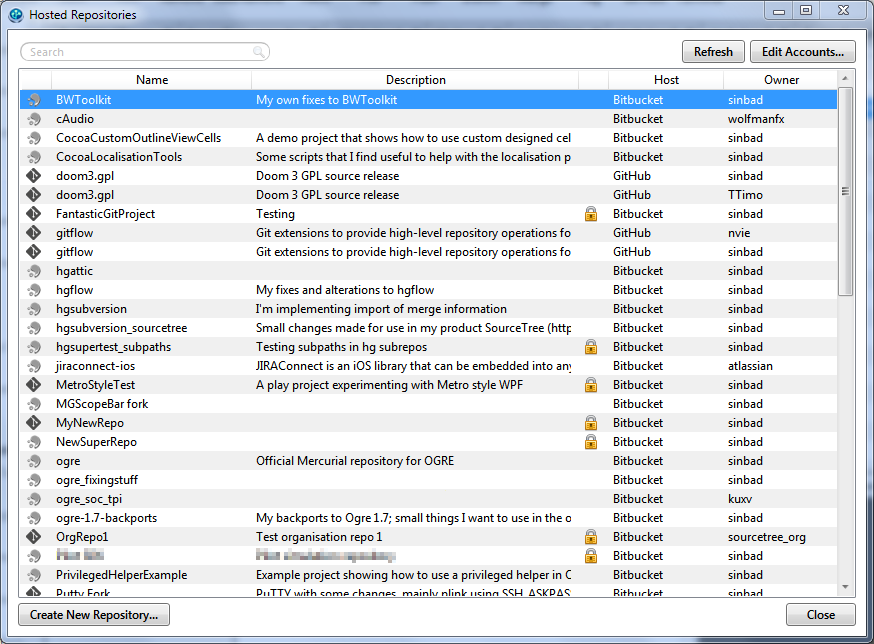

- BITBUCKET SOURCETREE FOR BEGINNERS INSTALL
- BITBUCKET SOURCETREE FOR BEGINNERS WINDOWS 10
- BITBUCKET SOURCETREE FOR BEGINNERS PASSWORD
- BITBUCKET SOURCETREE FOR BEGINNERS WINDOWS
BITBUCKET SOURCETREE FOR BEGINNERS INSTALL
To install that version of Python, just go to the main Python website.  To get the version used on PythonAnywhere, I start a Python session. Base interpreter: I'm guessing it's probably a good idea to set the base Python interpreter to be the same version as that used on PythonAnywhere. This will create a new folder named 'venv' in the project folder. Name: Once you've selected the 'Location' field, type 'venv' in the 'Name' field. Fill out the fields in the modal that appears. Click the gear icon in the top right and select "Add". Navigate to "Project: project_name" → "Project Intepreter". With the project open, go to 'File' → 'Settings'. It'll ask you if you want to create the project from existing sources. Interpreter: Ignore this / leave any value we'll set the interpreter after creating the project. You may need to click into the 'Documents' folder to see the name of the folder, e.g. C:\Users\Nathan\Documents\project_name. Location: Click the "." button and navigate to the folder created by SourceTree. You'll be presented with a "New Project" window/modal. Otherwise, if the "Welcome to P圜harm" window appears. Create a P圜harm project in the new directory that SourceTree created on your hard drive. Go back to SourceTree and try pasting in the URL again and then clicking out of the textbox, and you should see several new options (including the "Clone" button) show up.
To get the version used on PythonAnywhere, I start a Python session. Base interpreter: I'm guessing it's probably a good idea to set the base Python interpreter to be the same version as that used on PythonAnywhere. This will create a new folder named 'venv' in the project folder. Name: Once you've selected the 'Location' field, type 'venv' in the 'Name' field. Fill out the fields in the modal that appears. Click the gear icon in the top right and select "Add". Navigate to "Project: project_name" → "Project Intepreter". With the project open, go to 'File' → 'Settings'. It'll ask you if you want to create the project from existing sources. Interpreter: Ignore this / leave any value we'll set the interpreter after creating the project. You may need to click into the 'Documents' folder to see the name of the folder, e.g. C:\Users\Nathan\Documents\project_name. Location: Click the "." button and navigate to the folder created by SourceTree. You'll be presented with a "New Project" window/modal. Otherwise, if the "Welcome to P圜harm" window appears. Create a P圜harm project in the new directory that SourceTree created on your hard drive. Go back to SourceTree and try pasting in the URL again and then clicking out of the textbox, and you should see several new options (including the "Clone" button) show up. BITBUCKET SOURCETREE FOR BEGINNERS WINDOWS
Right-click on Pageant from the Windows task tray and select "Add Key". Add the private key to Pageant on your computer. Paste in the text from the Puttygen program and give it an easy-to-remember name. In the Settings page, click "SSH keys". In Bitbucket, select your profile image in the bottom-left, and then click "Bitbucket settings". Save the public key to your Bitbucket account. Click "Save public key" and name it something like "bitbucket_public_key". Save the file to an easy-to-find directory and name it something memorable. Fill out the "Key passphrase" and "Confirm passphrase" fields. A bunch of text will appear in the modal. In the Putty Key Generator, click "Generate". Click Tools → Create or Import SSH Keys. Generate a public/private key pair with Puttygen. Click "No" in the dialog to stop it from trying again. When you click out of the textbox, if you see an error about not having SSH keys. Paste the URL you copied from Bitbucket into the "Source Path / URL" field. Clone the new repository in SourceTree. If you did a 'git clone' and used a URL that begins with 'https', you need to change the URL to start with 'ssh' instead, otherwise it won't use your SSH key and will instead prompt you for your password:. Copy the contents of the id_rsa.pub file and add a new SSH key entry for your Bitbucket account, name it 'PythonAnywhere', and paste in the contents of the id_rsa.pub file.  Do a 'cat' on the id_rsa.pub file it creates to display the contents of the file. You can hit just hit enter for all of the options it presents you (i.e. From a PythonAnywhere bash console, run 'ssh-keygen'.
Do a 'cat' on the id_rsa.pub file it creates to display the contents of the file. You can hit just hit enter for all of the options it presents you (i.e. From a PythonAnywhere bash console, run 'ssh-keygen'. BITBUCKET SOURCETREE FOR BEGINNERS PASSWORD
Give it your Bitbucket password when it asks for it.Type "git clone ", then paste the URL you copied from Bitbucket into the console (use Ctrl+v) and hit "Enter".Navigate to the directory you'd like this repository to live in.

Clone the new repository in PythonAnywhere.Select the URL in the top-right corner of the page.Click the "+" icon in the top left corner and then click 'Repository'.If you need to log in, get the login credentials from LastPass.Create a new repository on Bitbucket / GitHub.
BITBUCKET SOURCETREE FOR BEGINNERS WINDOWS 10
I was using Windows 10 when following the steps below, so some things may be different on macOS / Linux.








 0 kommentar(er)
0 kommentar(er)
